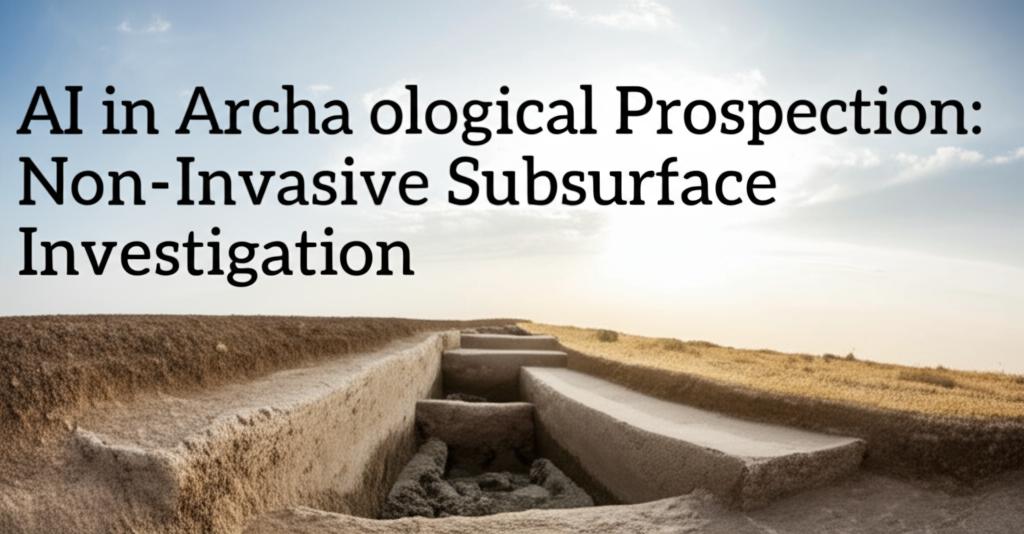Artificial intelligence (AI) is increasingly revolutionizing archaeological prospection, offering powerful new tools for non-invasive subsurface investigation. These technologies allow researchers to discover and analyze historical sites with greater speed, accuracy, and a reduced need for costly and potentially destructive excavations.
One of the primary applications of AI in this field is the analysis of vast quantities of data acquired through remote sensing techniques. AI algorithms, particularly machine learning (ML) and deep learning (DL) models, are adept at processing information from satellite imagery, Light Detection and Ranging (LiDAR), and Ground-Penetrating Radar (GPR). These algorithms can identify subtle anomalies and patterns in the data that might indicate buried archaeological features, such as ancient structures, tombs, or changes in soil composition and vegetation growth.
Key AI-driven Non-Invasive Techniques:- Satellite Imagery and Remote Sensing Analysis: AI analyzes satellite imagery, including multispectral and hyperspectral data, to detect surface and subsurface anomalies indicative of past human activity. Changes in vegetation patterns, soil moisture, or thermal properties, often invisible to the human eye, can be identified by AI, helping to pinpoint potential archaeological sites over large and often remote areas. For instance, researchers have successfully used AI with satellite imagery and Synthetic Aperture Radar (SAR) data to locate archaeological features in desert environments.
- LiDAR Data Processing: LiDAR technology creates detailed 3D maps of the ground surface, even penetrating dense vegetation. AI algorithms process this LiDAR data to identify subtle topographical variations that could represent buried structures or ancient landscapes. This has proven particularly effective in revealing features obscured by forests or other challenging terrains.
- Geophysical Data Interpretation: AI is being used to analyze data from geophysical surveys, such as GPR and magnetometry. These methods send signals into the ground and record the reflections or variations to detect subsurface features. AI, including Convolutional Neural Networks (CNNs) and U-Net architectures, can automate the interpretation of complex GPR data, identifying anomalies that might correspond to archaeological remains. This is especially valuable for interpreting the large datasets generated by modern multi-sensor arrays.
- Predictive Modeling: By integrating various datasets – including topographical maps, climate data, historical records, and remotely sensed information – AI can develop predictive models to identify areas with a high likelihood of containing archaeological sites. This helps archaeologists focus their resources on the most promising locations, increasing the efficiency of site discovery.
- 3D Modeling and Reconstruction: AI algorithms can analyze 2D images, such as historical photographs or aerial shots, to generate accurate 3D models of archaeological sites and artifacts. This facilitates the virtual reconstruction of fragmented objects and damaged structures, offering insights into their original form and construction.
- Enhanced Efficiency and Speed: AI significantly speeds up the process of data analysis and site identification, allowing researchers to cover vast areas and process large volumes of information much faster than manual methods.
- Increased Accuracy: AI algorithms can detect subtle patterns and anomalies that human analysts might miss, leading to more precise interpretations and a reduced likelihood of human error.
- Non-Invasive Nature: A key advantage is the ability to investigate subsurface features without physical excavation. This preserves the integrity of archaeological sites and artifacts for future study and reduces the cost and labor associated with traditional digs.
- Accessibility to Remote Areas: AI, combined with technologies like drones and satellite imaging, allows for the exploration of remote or inaccessible regions where on-the-ground surveys would be difficult or impossible.
- Cost-Effectiveness: By focusing efforts on high-probability sites, AI helps optimize the allocation of resources and makes archaeological projects more financially sustainable.
- Data Integration and Management: AI can integrate and analyze diverse datasets from various sources, providing a more comprehensive understanding of archaeological landscapes.
- Data Quality: The accuracy of AI predictions heavily relies on the quality and completeness of the training data. Biased or incomplete datasets can lead to inaccurate results.
- Ethical Concerns: The use of AI in archaeology necessitates careful consideration of cultural heritage protection, the rights of indigenous communities, and potential biases in algorithmic interpretations.
- Need for Interdisciplinary Collaboration: Successful implementation requires close collaboration between archaeologists, data scientists, and AI experts.
- Risk of Over-Reliance: There's a potential for digital tools to overshadow traditional archaeological skills. A balance must be struck to ensure that human expertise, critical thinking, and creativity remain central to archaeological interpretation.
- Model Transferability: AI models developed for one region or type of archaeological feature may not always perform accurately in different environments or for other types of sites without retraining or adaptation.
Despite these challenges, the integration of AI into non-invasive archaeological prospection is transforming the field. It offers unprecedented opportunities to discover, document, and understand our past while minimizing the impact on fragile archaeological resources. As AI technology continues to evolve, its role in unearthing and interpreting human history is set to expand even further.

